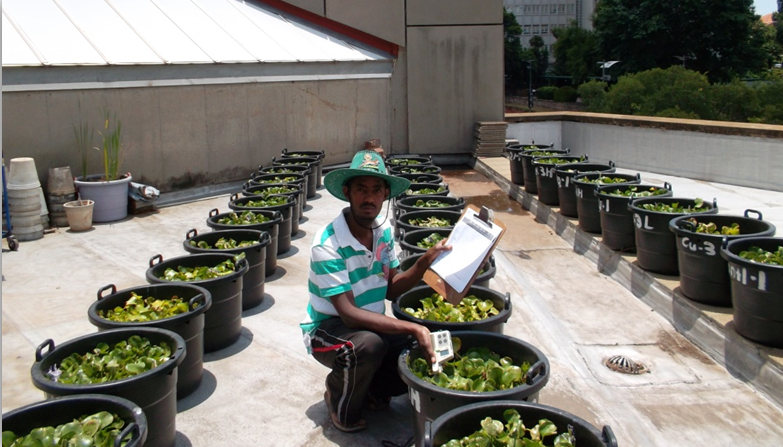28 November 2016 | By Solomon Newete
C·I·B researchers at the University of the Witwatersrand recently demonstrated that the invasive aquatic weed, water hyacinth (Eichhornia crassipes), can be used to remove metal pollutants from water. Through a process called phytoremediation – literally a “green” technology – plants are used to remove pollutants from the environment by absorbing them into their roots.
Water hyacinth is characterised by fast growth and despite being a notorious and aggressive invader, it has been widely researched as a potential agent for phytoremediation. Its efficiency, however, relies on the type of contaminant, concentration and eventual storage site in the plant tissues.
In the study, C·I·B researcher, Marcus Byrne and post-doctoral fellow, Solomon Newete, performed a series of experiments on water hyacinth to see whether it is able to remove metal salts from water; where it stores the metal pollutants and how it responds to metal toxicity. Experiments were conducted as single element trials with one each for gold (Au), copper (Cu), iron (Fe), mercury (Hg), manganese (Mn), Uranium (U) and zinc (Zn).
The results showed that over 80% of the metal contaminants in the water were removed by water hyacinth. Up to 98% were accumulated in the roots, of which 30% – 52% was adsorbed to the root surface.
“Tolerant plants retained most of the heavy metals in their roots, where the toxicity in minimal, while others reduce the metal toxicity in the shoots by excreting the cations. This is a strategy by which water hyacinth avoids toxic metals reaching the more susceptible shoots,” explains Solomon, lead author of the paper published in the journal Environmental Science and Pollution Research.
Bioconcentration is a process by which the quantity of a chemical in an aquatic organism exceeds that of its concentration in the water surrounding that organism. The bioconcentration factor of copper (Cu), mercury (Hg), gold (Au) and zinc (Zn) in the study exceeded 1 000, meaning that water hyacinth is a hyper accumulator with regards to these metals. The study found that water hyacinth was generally tolerant to all the metal contaminants, except for copper (Cu) and mercury (Hg).
“Although water hyacinth has the potential for many phytoremediation roles, this must be weighed up against its ability to invade waterways,” says Solomon “knowing whether metals are adsorbed, or assimilated in the plant and their allocation between the roots and shoots will inform decisions how to re-treat the biomass for metal recovery, or safe disposal after phytoremediation.”
Read the paper in Environmental Science and Pollution Research
For a related article by Solomon Newete in Biological Control
Newete, S.W., Erasmus, B.F.N., Weiersbye, I.M. and Byrne, M.J. 2016. The effect of water pollution on biological control of water hyacinth. Biological Control. Volume 79, Pages 101–109. http://dx.doi.org/10.1016/j.biocontrol.2014.08.006
For more information, contact Solomon Newete at Solomon.Newete@wits.ac.za


